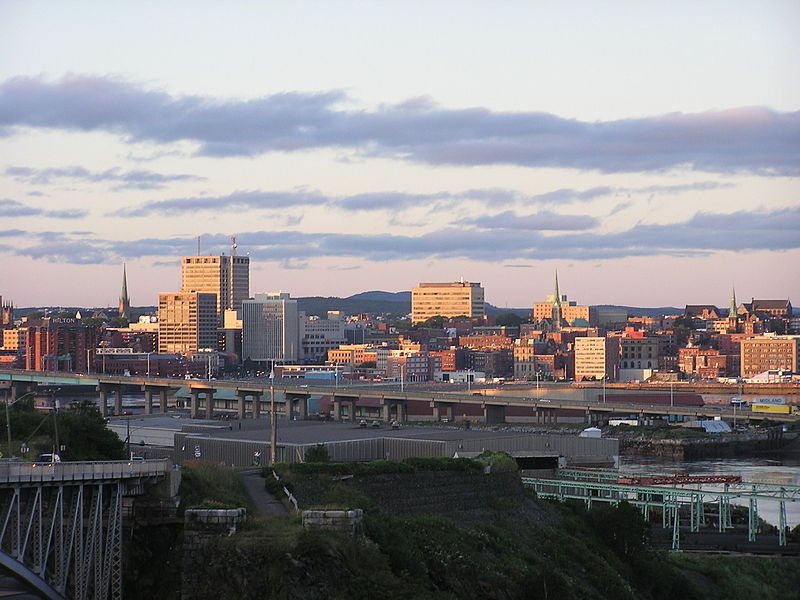Saint John, the great metropolis of New Brunswick.
—
Part 7.—What to See in New Brunswick.
New Brunswick, or le Nouveau-Brunswick, is Canada’s only officially bilingual province, with Acadian French speakers making up about a third of the population. Many U. S. visitors are surprised to learn that; they would have guessed that Quebec was bilingual, but in fact Quebec has been officially French-only since 1969 and thinks its English-speaking residents should go stick their heads in properly sized individual buckets of water. Like everything else of purely local interest, the bilingual status of New Brunswick is enshrined in the Canadian constitution, which also specifies the dimensions of the buckets of water in which Anglophone Quebecers are to stick their heads.
New Brunswick was founded as a refuge for American loyalists who fled the new United States after the Revolutionary War. The founders meant to show those rebels a thing or two by setting up a colony that would be “the envy of the American states”; and indeed, at its current rate of growth, the population of New Brunswick may soon surpass the population of greater Dayton. Mission accomplished.
The most important attraction in New Brunswick is Magnetic Hill, one of earth’s most mysterious places. At Magnetic Hill, just outside the city of Moncton, you stop your car at the top of the hill and put the transmission in neutral, and then the car rolls down the hill by itself as if attracted by a mysterious invisible force. At the bottom of the hill is a large souvenir-keychain emporium.
Fueled by the souvenir-keychain industry, Moncton has become the largest metropolitan area in New Brunswick. But there is nothing to see in Moncton except miles of keychain factories and the gleaming new glass-walled headquarters buildings of the international keychain conglomerates, so we move on to the real city in New Brunswick.
Saint John, until recently the largest metropolis of New Brunswick, is home to Reversing Falls, a fascinating phenomenon in which the raging rapids on the Saint John River actually change their direction of flow. The moment of transition is tremendously exciting, as you can see from this series of photographs:
Inbound Flow.
Transition.
Outbound Flow.
Photos by Wikimedia Commons user BenFrantzDale. GNU Free Documentation License.
Saint John was also the place where the great Henry Burr was discovered, and anyone who, like Dr. Boli, still has a large collection of acoustical phonograph records will wish to make a pilgrimage to the Imperial Theatre to pay homage.
Fredericton is the provincial capital, which makes it the place to go if you want to see a bilingual provincial parliament at work. It is not as entertaining as it sounds.
The Bay of Fundy, which separates New Brunswick from Nova Scotia, is famous for having the highest tides in the world. Tourists love to clamber among the Rocks at Hopewell Cape when the tide is out. Then the tide comes in and sweeps them all away, and their mangled corpses are picked up on Cape Cod beaches some weeks later.
Northwestern New Brunswick is an Acadian stronghold, and possibly the only place in Canada where a tourist will not be able to converse with the locals in ordinary English. The surprising number of monolingual Francophones may make it necessary to shout very loudly, which is of course always the key to making oneself understood to people who speak no English.



